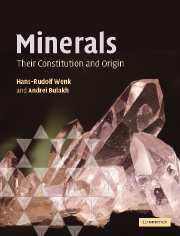Book contents
- Frontmatter
- Contents
- Preface
- Acknowledgments
- Figure credits
- Part I Structural features of minerals
- Part II Physical investigation of minerals
- Part III Variety of minerals and mineral-forming processes
- Part IV A systematic look at mineral groups
- Part V Applied mineralogy
- 30 Metalliferous mineral deposits
- 31 Gemstones
- 32 Cement minerals
- 33 Minerals and human health
- 34 Mineral composition of the solar system
- 35 Mineral composition of the earth
- Appendices
- Glossary
- References
- Index
- Plate section
- References
35 - Mineral composition of the earth
from Part V - Applied mineralogy
- Frontmatter
- Contents
- Preface
- Acknowledgments
- Figure credits
- Part I Structural features of minerals
- Part II Physical investigation of minerals
- Part III Variety of minerals and mineral-forming processes
- Part IV A systematic look at mineral groups
- Part V Applied mineralogy
- 30 Metalliferous mineral deposits
- 31 Gemstones
- 32 Cement minerals
- 33 Minerals and human health
- 34 Mineral composition of the solar system
- 35 Mineral composition of the earth
- Appendices
- Glossary
- References
- Index
- Plate section
- References
Summary
Chemical composition of the earth
After Chapter 34's excursion into the mineralogical composition of the universe, we return to earth to review the most important mineral components of our planet. On earth, only minerals located in the crust or suspended in the atmosphere and hydrosphere (oceans, lakes, and rivers) are accessible to direct investigation. Except for a few locations, where upper mantle material has been juxtaposed with the crust, the mineralogical compositions of the deeper zones can only be inferred from indirect evidence provided by studies of gravity, inertia, seismic wave propagation, magnetism, phase stability, and the general abundance of elements.
Particularly important for determining the structure of the earth's interior are seismic waves. Their velocities increase with the elastic stiffness and the density of the material they pass through. Therefore one can draw conclusions about the material, on the basis of travel times. Furthermore (as was discussed briefly in Chapter 8), there are two types of seismic waves. Longitudinal (or P waves) pass through solids as well as liquids, whereas transverse waves (S waves) pass through only solid material. This distinction can be used to identify regions of melt within the earth.
Figure 35.1 shows a profile of the average longitudinal and transverse wave velocity from the surface to the center of the earth, as well as the average increase in density and temperature.
- Type
- Chapter
- Information
- MineralsTheir Constitution and Origin, pp. 586 - 598Publisher: Cambridge University PressPrint publication year: 2004
References
- 1
- Cited by



